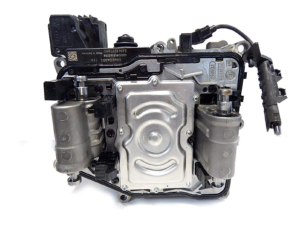The DSG Transmission is used in a number of manufacturers including VW, Audi, Skoda and Seat.
The technology is relatively new in the automotive industry and with all new things in our game, the consumer becomes the test dummy.
The first few years of these things saw a huge list of problems, fair trading and the ACC were regularly contacted by upset consumers. The technology has now vastly improved however the issues and fail rates are still dramatically high in my opinion.
Firstly what is a DSG transmission.
DSG stands for Direct Shift gearbox and the concept is basically to take the ease of driving an automatic and give the vehicle the fuel economy of driving a manual.
A traditional automatic transmission uses a number of clutch packs to produce the desired output ratio. The biggest cost of this is fuel efficiency, alternatively manual transmissions have one plate that is manually operated by the vehicle driver, this does mean the driver has to deal with clutch pedals, friction points and gear levers.
The DSG incorporates the best of both worlds into its design. Using an advanced electro-hydraulic control module to control clutch application and gear shifting, the DSG can bring the driving comfort of a full automatic to the table while still getting the greater efficiency of the manual-style gears. Furthermore, it makes use of a dual clutch assembly, where one clutch is responsible for even numbered gears and the other for odd-numbered gears, improving shifting quality further.
A great idea and it even works, however many consumers are having problems. Here is the list of things to watch out for with DSGs.
Shudder/ shaking
There are two causes for Shuddering.
The first which is far more common than the other is the duel mass flywheel. If you experience the shudder when you start the engine and when the car is idling, often accompanied by a loud clattering noise, the problem is in the dual mass flywheel which sits between the transmission and the engine. The flywheel consists of two plates that can move a small amount in relation to each other. This provides a cushioning effect when torque is transferred from the engine to the transmission. When that flywheel wears down, and the amount of movement is too great, you get a juddering/shuddering sensation.
It’s important not to leave this fault for too long. If the two flywheel plates sheer off from each other, your vehicle will lose drive entirely.
Dual mass flywheels are the source of many juddering problems incorrectly attributed to a DSG transmission.
To replace the Duel mass Flywheel the transmission has to be removed from the vehicle. This can be costly but if you leave it, the flywheel can fail completely and you will have to remove the transmission anyway and potentially replace other components too.
If your flywheel is fine, however, and the juddering sensation is most noticeable on gearshifts—particularly at lower speeds—the problem likely lies in the dual clutch assembly. This is more prevalent if you are slowing down to give way and accelerate away without having come to a complete stop.
If this is your fault, you are up for a transmission overhaul. Don’t leave it to long as they have been known to completely fail leaving you stranded with a vehicle that will not drive.
Oil Leaks:
These transmissions are known to hose oil out. Most we have seen don’t leak past the seal themselves but rather from the centre of the box where the two halves of the casting meet. To rectify this the transmission has to be removed and the transmission stripped and resealed. We advise getting a rebuild done as the labour involved is mostly in the transmission removal. Its a no brainer.
Servicing: Some manufacturers that use these boxes state that they are “Fill for Life” its important to understand that Fill for life is not your life but rather its the life of the car which the manufacturer deems to be five years or 100,000kms (in most cases) no oil in any car never needs replacing. These transmissions still require servicing and oil changes, it can get expensive as speciality tools are required to do this.
Mechatronic Failure
 Check engine light on and the transmission drops into limp mode and failsafe mode—is a failure state of the transmission where it detects a fault and limits itself to one gear (typically third) to limit damage to the transmission. If your transmission has gone into limp mode, there will be trouble codes in there to explain why it’s done this. You’ll need to get your vehicle scanned and someone to diagnose this properly. Do not replace parts based of codes only.
Check engine light on and the transmission drops into limp mode and failsafe mode—is a failure state of the transmission where it detects a fault and limits itself to one gear (typically third) to limit damage to the transmission. If your transmission has gone into limp mode, there will be trouble codes in there to explain why it’s done this. You’ll need to get your vehicle scanned and someone to diagnose this properly. Do not replace parts based of codes only.
If the codes mention “clutch limits reached” (or something similar), there’s a good chance the problem is your clutch. Typically (though not always) this won’t occur until after the aforementioned juddering/shuddering fault. If the codes mention “adaptations,” it’s possible that your problem may be fixed with an adaptation reset.
The mechatronic is by far the most common cause of DSG transmission woes.
If the codes mention any sensors, gear ratios, or unexpected mechanical disengagements, the problem is almost certainly your mechatronic. The mechatronic is the name given to the electro-hydraulic control unit that is responsible for controlling the gearbox, and it’s a very expensive lump.
Warning! Many companies claim to be able to repair these mechatronic units, don’t do it. Often these companies are limited in what they can test for and repair in these mechatronic units.
Bear in mind, with these repair companies, “tested ok” means no fault found. These test procedures assume a component is working as intended unless adult is located. No fault found and it passed the QC test. These companies often can’t locate the fault and send the unit back as passed. Now you won’t know they missed the fault until the whole thing is back in the car and you think you have finished the job only to find out you have to do it again.
Bite the bullet and buy a mechatronic unit, do the job once and sleep easy.
Warriewood
-
Unit 3, 13 Ponderasa Pde
Warriewood NSW 2102 - 02 9979 5933
Hornsby
-
2/ 27 King Road
Hornsby NSW 2077 - 02 9987 2818
DSG Transmission Fault

Would You Like To Speak With The GDL Team?
Simply choose the option below that suits you best.
OR
Our Locations
Warriewood
3/ 13 Ponderasa Pde
Warriewood NSW 2102
02 9979 5933
Hornsby
2/ 27 King Road
Hornsby NSW
2077
02 9987 2818
Our Services
Follow Our Socials
Our Locations
Warriewood
3/ 13 Ponderasa Pde
Warriewood NSW 2102
02 9979 5933
Hornsby
2/ 27 King Road
Hornsby NSW 2077
02 9987 2818
Our Services
© Copyright GDL Auto 2022 | Website & Marketing By GREENhouse Media
© Copyright GDL Auto 2022 | Website & Marketing By GREENhouse Media
